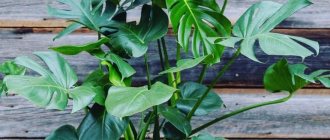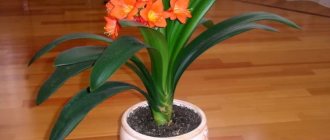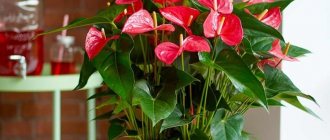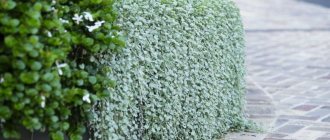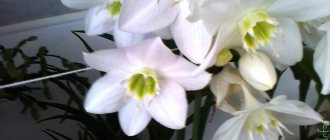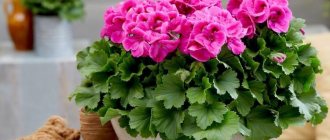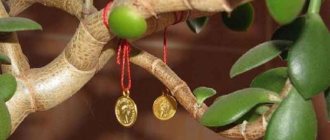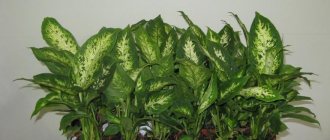The genus Carissa is directly related to the cucumber family (Apocynaceae). This genus includes approximately 35 plant species, which are represented by small, highly branching shrubs and trees. In nature, they can be found in the subtropical and tropical forests of Africa, Hong Kong and Australia.
The branches of this genus of plant have protective two-toothed thorns that are quite thick. There are species with very long spines (up to 5 centimeters). The opposite leathery leaves have rather short petioles. Simple oval leaves can reach from 3 to 8 centimeters in length. The leaf blade is slightly folded along the central vein. The leaves themselves have a rich, dark green color, and the veins are painted in a pale green color. Young shoots are also painted pale green.
The plant blooms for a very long time, or rather, almost the whole year. Tubular, simple flowers have 5 petals. They can be painted pink or white, and flowers grow in the leaf axils at the tips of the stems. Flowers can be collected in few-flowered inflorescences or be solitary. Outwardly, they have a clear resemblance to jasmine sambac flowers, and differ only in their less strong aroma. The diameter of the flower can reach 1–5 centimeters.
At the end of flowering, fruits of not very large size appear in place of the flowers, which are similar in appearance to plums. The size of such fruits is directly dependent on the type of plant. So their size varies from 1.5 to 6 centimeters. At first the fruit is colored red, but over time its color changes to black or dark purple. These fruits can be eaten and have excellent taste. The pulp, which has a strawberry aroma, is very tender and juicy. Carissa is cultivated as a fruit tree, grown in gardens.
CARISSA, OR ROOM PLUM.
General information
The plant has unusual hard, round-oval, green glossy leaf blades with a spike at the end. The inflorescences are white, large, exuding a pleasant aroma during flowering.
In addition to beautiful flowers and decorative appearance, the crop can please you with medium orange-red fruits that are similar to plums. They can be eaten. The fruits have a sweet and sour pleasant taste.
Indoor plum is ideal for growing at home. This spectacular crop is absolutely not capricious and undemanding to care for, which means even novice gardeners can acquire it.
Araucaria
A coniferous plant with thin delicate branches and the same trunk. If you run your palm over an araucaria, it will not prick. Which is quite surprising, because her forest sisters are completely different. The most difficult thing in caring for a plant is maintaining the required level of humidity in the room. Because the dry air makes the branches of Araucaria dry out. If left unattended, the plant will eventually die.
Another important condition for the normal cultivation of conifers: the correct temperature. She prefers it cool
In the summer months, the temperature should not rise above +20 degrees. But in winter, the coniferous beauty needs to create cool conditions - 5 degrees Celsius. At the same time, icy drafts are undesirable. The plant loves sunlight, which plays a big role in proper development. But the flower needs to be shaded from direct sun.
Carissa types and varieties with photos
Carissa Variegate - the shrub reaches a height of 50 to 100 centimeters. It differs from other varieties in its variegated, oval leaf blades with a glossy surface and small spines at the ends. The inflorescences of the culture are white with a pleasant aroma. After flowering, small light red fruits are formed in taste and aroma, reminiscent of plums. However, at home, fruiting of this variegated plant is rarely achieved.
Carissa Large-fruited - the shrub can reach up to 4 meters in length and has a highly branched crown. The leaf blades are leathery, dark green, round, dense with spines at the ends. The inflorescences are large, star-shaped, white in color with a pleasant aroma. The crop blooms from May to September. The fruits of the plant resemble plums, are medium in size, have a pomegranate hue and a sweet and sour taste. They ripen from September to October.
Carissa Edible is a fast-growing, evergreen shrub, reaching a height of up to 3 meters. The plant has a wide crown. The branches of the crop are covered with thorns. The leaf blades are dark green, leathery, glossy, oval. The inflorescences are tubular, white in color. Flowering time continues all year round, but its peak occurs between May and September. The crop bears fruit with bright crimson fruits with juicy pulp that tastes like strawberries.
Carissa grandiflora
It is a fruit-bearing evergreen shrub native to South Africa. The plant reaches a height of up to 5 meters and has a highly branched crown. The leaf blades are dark green, oval, glossy. The inflorescences are white with a pleasant aroma. The fruits are oblong, small, red in color with juicy pulp.
Carissa indoor plum is a plant variety suitable for indoor growing. It reaches a height of up to 100 centimeters. It has glossy, leathery, oval, dark green leaf blades. The inflorescences have a white tint and a pleasant aroma. Flowering time lasts from May to September. The crop bears red, juicy, small oval fruits that ripen in October.
Carissa Karanda - in natural conditions the shrub reaches a height of up to 5 meters. It has a strongly branching crown and branches with strong thorns. The leaf blades are elliptical, leathery, glossy, dark green. The flowers are tubular, white-pink in color with a pleasant jasmine aroma. The fruits are medium-sized, red in color with juicy, sour-bitter pulp and brown, flat seeds inside.
Carissa Macrocarpa
A shrub reaching a height of up to 5 meters and having a dense, spreading crown with prickly, numerous branches. The leaves are oval, leathery, dark green, glossy. The inflorescences are tubular, white in color with a sweet jasmine aroma. The fruits are small, purple in color, with juicy pulp and flat seeds.
Carissa Bispinosa - the plant can reach a height of up to 3 meters. The shrub has oval, leathery, glossy leaf blades, dark green in color with pointed ends. The inflorescences are medium-sized, white in color with a strong pleasant aroma. The fruits are small, coral in color with juicy, sour flesh.
Carissa Spinarum - grows wild in Africa and Australia. It reaches a height of up to 5 meters. It has leathery, glossy, oval leaf blades with spines at the ends. The inflorescences are large, tubular with long white petals with a pleasant, persistent aroma. The fruits are medium dark purple with sweet and sour pulp.
Carissa Tetramera - grows wild in Zimbabwe, Tanzania and Mozambique. It reaches a height of up to 3 meters and has a dense, wide crown. The leaf blades are leathery, dark green, glossy, oval with a spine at the end. The inflorescences are tubular, white-pink with a persistent, pleasant aroma. The fruits are bright red, medium-sized with juicy sweet and sour pulp and dark brown seeds.
Description of the plant
The branches of the plant have thick two-toothed thorns. They serve as a kind of protection, their length can reach about 5 cm. The arrangement of the leaves is opposite, the leaf blades are small oval in shape, grow 3-8 cm long and are colored light green. Thanks to this feature, they stand out against the background of other greenery.
The flowering period can last throughout the entire season. The flowers of the plant resemble jasmine, but do not have the ability to exude the same dizzying aroma. The five-petal inflorescences are small, formed in the leaf axils and colored pink.
Flowering ends with the formation of purple or black fruits that look like plums. Their diameter is 1.5-6 cm. The dimensions are determined by the parameters of the tree itself. Their value lies in the tender and juicy pulp, which smells like strawberries. Carrisa is often grown as a cultivated plant in many garden plots and produces a good harvest along with other fruit trees.
Carissa home care
The plant belongs to the light-loving category, for this reason the ideal place to place it is a south window. The culture is not afraid of direct sunlight, but, on the contrary, receives the maximum benefit from it. It is impossible to place the plant on a north-facing window, as due to a lack of light it will slow down in growth, the stems will begin to stretch, and there will be no flowering.
In summer, the optimal temperature for the crop will be considered to be from 18 to 25 degrees. In winter, during the dormant period, the carissa will need to be moved to a cool place with a temperature of 14 to 18 degrees. By creating such a microclimate for the shrub, it will be possible to achieve abundant flowering in the summer. The culture is resistant to sudden temperature changes and has high frost resistance. In summer, the plant should be taken out into the fresh air and left there until autumn, which will benefit it.
Carissa does not need high humidity. She will feel comfortable even in winter, when the air in the room is dry due to the influence of heating devices. To improve the appearance of the plant, from time to time it needs to be given a warm shower.
Plumeria is also a member of the Kutrovaceae family. It can be grown with care at home without much hassle if you follow the rules of agricultural technology. You can find all the necessary recommendations in this article.
Making a silicone mold with your own hands
In addition to the fact that you can buy a mold for making gypsum tiles on the market, you can make it yourself. In order to make a mold for gypsum tiles, say, to look like a brick, you will need:
- Silicone Alcorsil 315.
- Catalyst.
- Ordinary plasticine.
- Blank for the mold (full imitation of brick).
- Soap solution.
- For the bottom you will need glass or laminated chipboard.
Materials for making silicone mold The mold making process is as follows:
The walls for the mold are made from plasticine. They should not have clear boundaries and perfectly smooth edges; The workpiece should be placed on a perfectly flat and clean surface. If brick-like tiles are required, then the workpiece should ideally be brick; Walls are made of plasticine around the false brick. There should be a distance of 1 cm from the brick to the wall;
And also the wall should be 1 cm higher than the brick. This distance will serve as the bottom of the mold; After the walls are finished, the entire border between the plasticine and the base should be sealed. This is required so that the silicone does not spill out; Next, you need to treat the entire surface inside with a soap solution. This needs to be processed without skipping places. The mold will not come off in the place where there was no soap solution; A mixture of silicone and a chemical composition (catalyst) is made; The mixture is poured into the prepared form with the workpiece;
When silicone hardens, it becomes elastic
This is very important, especially when it is intended to make thin tiles (1cm). Other types of silicone are rough after hardening, which creates a problem during tile production; The mold is completely ready for tile production after two hours; If the silicone is not cured, it will stick to your hands.
Ready-made silicone mold with your own hands After removing the mold for gypsum tiles, you can use it. In this form, you can make 2 thousand casts of gypsum tiles. The video shows the process of making a silicone mold for gypsum tiles.
Watering carissa
Watering should be moderate but regular. The plant is drought-resistant and can withstand almost complete drying of the soil, but overwatering is very dangerous for the crop. It can lead to rotting of the root system and death of indoor plums.
Watering should be done with warm, settled water only when the top layer of soil is thoroughly dry.
Southern succulents
Agave
Tourists are amazed by the huge inflorescences, much taller than human height, emerging from aloe rosettes. No and no, it's not aloe, it's agave! Most impressive, of course, are the inflorescences of the American agave.
It is believed that agave blooms on its 100th anniversary, but this is not true: large species of agave bloom at 30-40 years of age, and miniature ones after a couple of years. By the way, they bloom only once in their life, then they die, leaving behind numerous root shoots. Interestingly, in some species, instead of flowers, young plants with roots appear on the inflorescence, which are capable of self-rooting.
The American agave, or centenary aloe (Agave americana), originates from Mexico, but has taken root well throughout the Mediterranean. This is a large perennial succulent plant with powerful, fleshy, succulent leaves collected in a basal rosette, the diameter of which in adult specimens can reach 3 m.
The inflorescence can reach a height of 10 meters or more and bear about 10 thousand bell-shaped yellow flowers up to 7 cm in diameter.
The name comes from agauos, which translated from Greek means “noble”, “wonderful”, “excellent” and it received it in honor of Agave, the daughter of one of the ancient mythical kings.
Agave americana flowering. Photo taken in Sicily.
Aloe
The ordinary tree-like aloe used to grow in almost every home, but it rarely bloomed, which is why it got its apt name “agagave.” In natural conditions, it blooms much more often, and many tourists are surprised at the beauty of its flowers, not recognizing their grandmother’s agave in this blooming beauty.
The genus Aloe (Aloe) itself includes about 340 species of perennial succulent plants, common in tropical regions of Africa, Southern and Eastern Africa, the island of Madagascar and the Arabian Peninsula. Among aloe there are both dwarf varieties with a rosette several centimeters high, and giants up to 10 m high, with a trunk diameter of up to 2 meters.
Externally, aloe is similar to agaves, but in nature, aloe blooms annually and the rosettes do not die off after flowering. Their inflorescences are smaller (maximum size 1.5 m tall), with small tubular flowers, usually yellow or red in color.
The most interesting types:
- Aloe tree, sabur, agave (Aloe arborescens) - in nature, their height is about 3 m or more. Peduncle about 80 cm long with a multi-flowered racemose inflorescence with red flowers, yellow inside.
- Aloe plicatilis, or Aloe plecatilis (Aloe plicatilis, Aloe lingua, A. linguaeformis, A. tripetala) - the species has unusual leaves for aloe: belt-shaped. The inflorescence is a simple raceme on a peduncle about 50 cm long, bearing 25–30 red flowers.
- Aloe variegated, or tiger aloe, “falcon feather” (Aloe variegate, Aloe punctata, A. ausana) - 30 cm high. Flowers up to 3.5 cm long, color from pink to dark red or scarlet with green stripes, yellow inside .
- Aloe vera, aloe Barbados, aloe vera (Aloe barbadensis, Aloe vera) - the peduncle has a height of 60–90 cm.
Aloe shortleaf (Aloe brevifolia) is a miniature species, rosettes up to 8 cm in diameter. Photo taken in Spain.
Opuntia
Probably the most favorite flowering cacti among tourists! Not a single photography enthusiast has ever left the sea without photographs of blooming prickly pear. Its yellow and orange flowers adorn many traveler's photo albums.
The prickly pear is native to North and South America. These are succulent plants with flat, disc-shaped stems and large, often multi-colored flowers of varying colors. By the way, some types of prickly pear have edible fruits! They are sold in Mediterranean countries, often already peeled, and eaten fresh.
The most famous is the ficus-indica prickly pear (Opuntia ficus-indica). It is precisely its fruits that are edible.
Prickly pear blossom, photo taken in Spain
Pereskia, Peireskia, Pereskia
The pretty pink flowers belong to Pereskia, the most common being Pereskia grandifolia (Pereskia grandifolia), native to Brazil.
Kstity, it’s very interesting that this is... CACTUS! More precisely, all pereskias are leaf cacti that bloom with rather large fragrant flowers.
Pereskia grandiflora in flowering period, photo taken in Spain.
Another interesting species is Pereskia aculeate, Cactus pereskia, native to Brazil, Uruguay and Argentina. Its flowers are yellowish-white with a pink tint in the center and are lightly scented. But the fruits are edible, yellow in color.
Soil for carissa
There are no special requirements for the soil of the mixture, but it is still better to plant the crop in slightly alkaline soil. Both humus and sandy soil will suit it. To prepare a soil mixture for planting indoor plums, you need to mix leaf, turf and peat soil in equal parts, adding sand and humus to them.
Expanded clay should be placed at the bottom of the pot, which will act as drainage and prevent liquid from stagnating in the soil.
Top dressing
For regular flowering and a large harvest of cream, phosphorus is needed, so fertilizers with a high content of it are needed.
Fertilizing with nitrogen will stimulate the growth of leaves, rather than flowers and fruits. In order for a spreading bush to bloom all year round, you need to constantly apply fertilizer.
Carissa transplant
Until the crop reaches three years of age, it will need to be replanted every spring. Then the transplant should be carried out every three years. This procedure is necessary for carissa to improve flowering and the formation of leaf blades.
Before starting the procedure, you need to prepare the soil, take a deeper and wider ceramic pot than last time and lay drainage made of fine expanded clay on the bottom. Then you need to remove the crop from the old planting container, shake off the root system from the soil and carefully transfer the plant to a new pot, filling it with the prepared soil mixture.
After transplantation, the carissa needs to be watered and removed from the windowsill for several days so that it is not exposed to direct sunlight.
Poisonous family
Almost all representatives of the Kutrovidae contain poisonous milky sap. They are the most dangerous plants in the world. If you have children or animals at home, you need to take precautions. It is best to use tall stands to limit access to the plant. All work with it must be done with gloves. Do not ignore this rule, even if you are accustomed to thoroughly washing your hands after working with your green pets. The poisonous juice contained in carissa stems can cause irritation and burns.
Carissa fertilizer
If a crop blooms and bears fruit throughout the year, it should be fertilized constantly every three weeks. If the grower does everything according to the rules and arranges a rest period for her, then during the rest, the plant does not need to be fertilized.
As a top dressing for carissa, mineral fertilizers are needed, which will ensure long flowering. Nitrogenous fertilizers should be limited, as they suppress flowering and provoke increased growth of green mass.
To avoid the development of chlorosis, iron chelates must be added to the soil along with watering for prevention.
Environmental requirements
Carissa macrocarpa
Requires a warm, humid subtropical climate. Tolerates different exposures, both full sun and fairly dense shade. As a coastal plant, it tolerates the salty spray of the ocean very well.
| Factor | Description |
| Precipitation | Up to 1000 mm/year |
| Drought | Drought-resistant and does not require watering during summer rains |
| Height | 1000 m above sea level (Swaziland); probably up to 1500 m. |
| Cold | Frost-resistant down to -5 ° C; young plants need protection |
| Warm | Up to 32°C in the shade (Pretoria); best growth in full sun |
| The soil | Any (limestone, heavy clay, sand) as long as it drains well |
| Salinity | Salt resistant (5000 ppm) |
carissa blossom
The flowering time of the crop, taking into account the dormant period, lasts from May to the end of September. The inflorescences of the plant are tubular, white or white-pink in color with a pleasant aroma.
If the plant is grown at home and the grower does not take it out into the open air, or there are no night pollinators in the region where the plant grows (the crop blooms at night, and the buds close during the day), in order to get fruit in the future, it must be pollinated independently using a soft brush, transferring pollen from flower to flower.
If the procedure is carried out correctly, after a while small bright red fruits with juicy, sweet and sour pulp will begin to appear.
Growing at home is very easy
Carissa is undemanding to air humidity, is not afraid of drafts, and in winter it tolerates warm conditions and a lack of light. The most suitable place is a well-lit window sill on the east or west side. With a lack of light, internodes lengthen. In summer, carissa feels best outdoors, in a sunny place. The range of tolerated temperatures is so wide that it allows you to keep the plant on the balcony or in the garden for more than five months a year. Carissa easily tolerates temperatures down to +6...+8 °C, and at night temperatures of +3 °C, a few lower leaves may just turn slightly red and fall off. During the day, however, it should be significantly warmer.
It is generally accepted that carissa needs a cool (+8...+14 °C) wintering. This condition is not mandatory, although it stimulates flowering. Carissa blooms 2-3 times a year. During flowering, you need to feed the plant with fertilizers for flowering plants. In summer, flowers can be pollinated by insects. Carissa fruits are similar to small citrus fruits and when ripe they turn a bright red-orange color and are edible. Unfortunately, it is very difficult to preserve them if you have to return the plant to the house. A sharp deterioration in lighting and dry air - and most of the fruits fall off.
One of the advantages of this plant is its drought resistance. With a prolonged lack of moisture, the leaves may wrinkle and then partially fall off, but the plant will survive and recover. Of course, it is better not to bring it to this state, but to water it moderately all year long when kept warm and reduce watering if it is cool.
Carissa pruning
The shrub grows very quickly, which leads to the loss of its decorative form. Therefore, even at the seedling stage, it is necessary to pinch the top above the fourth pair of leaf blades. Pruning of an adult plant should be carried out annually, starting in early spring and continuing until early summer, when the active flowering phase begins.
Pruning is a complex procedure. Carissa is considered the most capricious plant in terms of crown formation. It is quite difficult to form, since new branches begin to grow at different angles, which only complicates the procedure.
If the plant is not pruned, it will begin to grow and take up a lot of space on the windowsill, and given the fact that it has thorny branches, pruning in this state will be quite difficult.
When growing a crop from cuttings yourself, experienced gardeners recommend winding young shoots onto a support in a spiral or purchasing carissa with a formed crown with short internodes, a strong trunk and a large number of branches. Although the plant will begin to grow over time, pruning it will be much easier.
Lighting
This is one of the key points that must be taken into account. This plant is tropical and very heat-loving. In its homeland, it bathes in the rays of the hot sun. Therefore, at home you need to provide him with conditions close to natural. If you plan to grow carissa on a windowsill, then it must face the south side. As a last resort, western windows will do, otherwise you will need to organize additional lighting. If there is not enough light, the branches will stretch and the plant will take on a less than aesthetically pleasing appearance.
Caring for carissa during the dormant period
In order for the plant to grow, bloom and develop normally, the gardener needs to give it a rest period, which begins in October and ends in April. In order for the culture to rest, it should be moved to a cool room with temperatures ranging from 14 to 18 degrees.
Watering should be reduced slightly; water the crop when the soil is almost completely dry. Carissa cannot be fertilized at this time.
It is necessary to remove the tree from the dormant period in April, gradually returning to the usual care regime.
Pelargonium
Pelargonium (or geranium) became famous because of its unpretentiousness, healing properties and bright inflorescences. The plant will decorate any window sill or room interior. But even these easy-to-care flowers need attention and care.
The plant loves plenty of sunlight and warmth. From spring to autumn, good lighting is necessary, so do not be afraid to place a pot of pelargonium on a south-facing window. The most suitable temperature for pelargonium is 20 degrees Celsius. Exceeding this indicator can have a bad effect on the development of the flower.
In winter, you need to ensure rest and better adhere to optimal conditions for keeping
It is important to provide the flower with light, cool air +10...+12 degrees, water it rarely and protect it from drafts. Then in the spring pelargonium will delight you with lush flowering
Now you can purchase any of the listed flowers with peace of mind and grow them with pleasure, because their maintenance does not require special conditions.
Carissa growing from seeds
For propagation by seed, you need to use fresh seed material. At first, the seeds grow very quickly, but later their growth slows down significantly. A plant grown from seeds begins to bloom only in the second year.
To grow a crop from seeds, you need to prepare a container with soil mixture. Seeds should be planted one centimeter deep and three centimeters apart. After planting is completed, the soil must be sprayed with a spray bottle and the box covered with film, placing the mini-greenhouse in a warm, well-lit place.
The container should be ventilated daily and the soil should be systematically moistened. After the shoots appear, the film must be removed. When the plants grow to 7 centimeters, they need to be planted in separate pots, where they will grow until they are transplanted to a permanent place of growth.
What makes her so special?
A lovingly grown and well-formed plant looks very pretty and is somewhat reminiscent of ficus ficus, but during flowering it is impossible to compare these species. Blooming carissa instantly captivates people with a well-developed sense of smell. The scent of the lovely few flowers does not fill the room with a suffocating cloud, like oleander, and does not announce flowering as openly as tabernemontana. It floats in the air in a thin, almost imperceptible stream, forcing you to look for its source, and then keep coming back to it until the flowering ends.
Carissa propagation by cuttings
Carissa can also be propagated by cuttings, but this process is quite complex and painstaking. A plant grown in this way blooms in the first year.
To grow a crop from a cutting, you need to do the following. Select an apical cutting that will have three internodes. Then make a cut to half its thickness, leaving it for several hours, and after time, cut it off from the mother plant.
Next, it should be placed in heated soil, after keeping the cutting in the root. The cuttings should be planted in a mixture of perlite and peat. It should be kept under film for several weeks, ventilating the greenhouse daily and systematically moistening the soil. The rooting process will take about three months. Please note that the cuttings will not take root in water.
What foods contain vitamin B12?
Vitamin B 12 is not synthesized by either animals or plants; its content depends solely on the ability to store the vitamin produced by microorganisms (for example, bacteria in the soil). Animals have more such opportunities, so good sources of vitamin B12 are practically limited to animal products.
Excellent suppliers of B12 are veal liver and perch. There is a lot of cobalamin in the kidneys. Very good sources of vitamin B12 are salmon, scallops, shrimp, halibut, sardines, and cod. Meat products include lamb, beef, and game.
As for plants: kelp, blue-green algae; or other products: brewer's yeast, soy products (tempeh, miso, tofu), then the content of vitamin B12 in them is inconsistent and insufficient.
Diseases and pests
Carissa is resistant to various diseases; the only disease that can affect it is root rot , which develops due to improper watering. If a disease occurs, replanting and removing damaged parts of the root system will help save the plant.
Among the pests that pose a threat to the crop, spider mites , scale insects and thrips . When they appear, it is enough to treat the carissa with Actellik according to the instructions on the package and the insects will die.

